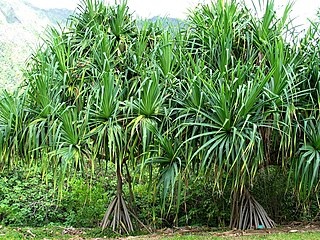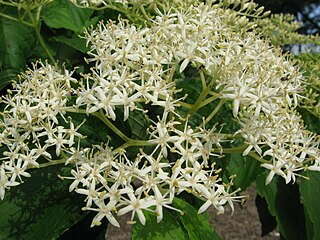
Hydrangea common names hydrangea or hortensia, is a genus of over 75 species of flowering plants native to Asia and the Americas. By far the greatest species diversity is in eastern Asia, notably China, Korea, and Japan. Most are shrubs 1–3 m tall, but some are small trees, and others lianas reaching up to 30 m (100 ft) by climbing up trees. They can be either deciduous or evergreen, though the widely cultivated temperate species are all deciduous.

Mahonia is a genus of approximately 70 species of evergreen shrubs and, rarely, small trees in the family Berberidaceae, native to eastern Asia, the Himalaya, North and Central America. They are closely related to the genus Berberis and botanists disagree on whether to recognize a separate Mahonia. Many botanists prefer to classify Mahonia as a part of Berberis because several species in both genera are able to hybridize, and because there are no consistent morphological differences between the two groups other than the leaf pinnation. However, recent DNA-based phylogenetic studies retain the two separate genera, by clarifying that unifoliolate-leaved Berberis s.s. is derived from within a paraphyletic group of shrubs bearing imparipinnate evergreen leaves, which are then divided into three genera: Mahonia, Alloberberis, and Moranothamnus ; a broadly-circumscribed Berberis would also be monophyletic.

Hydrangea macrophylla is a species of flowering plant in the family Hydrangeaceae, native to Japan. It is a deciduous shrub growing to 2 m (7 ft) tall by 2.5 m (8 ft) broad with large heads of pink or blue flowers in summer and autumn. Common names include bigleaf hydrangea, French hydrangea, lacecap hydrangea, mophead hydrangea, penny mac and hortensia. It is widely cultivated in many parts of the world in many climates. It is not to be confused with H. aspera 'Macrophylla'.

Pandanaceae is a family of flowering plants native to the tropics and subtropics of the Old World, from West Africa through the Pacific. It contains 982 known species in five genera, of which the type genus, Pandanus, is the most important, with species like Pandanus amaryllifolius and karuka being important sources of food. It is an ancient family dating from the early to mid-Cretaceous. This is a family that is not-well studied.

Berberis thunbergii, the Japanese barberry, Thunberg's barberry, or red barberry, is a species of flowering plant in the barberry family Berberidaceae, native to Japan and eastern Asia, though widely naturalized in China and North America. Growing to 1 m (3.3 ft) tall by 2.5 m (8.2 ft) broad, it is a small deciduous shrub with green leaves turning red in the autumn, brilliant red fruits in autumn and pale yellow flowers in spring. Numerous cultivars are available as ornamental plants suitable for hedging.

Magnolia champaca, known in English as champak, is a large evergreen tree in the family Magnoliaceae. It was previously classified as Michelia champaca. It is known for its fragrant flowers, and its timber used in woodworking.
The hybrid elm cultivar Ulmus × hollandica 'Macrophylla Aurea' was listed by Bean in Kew Hand-List Trees & Shrubs, ed. 3, 273, 1925 as U. montana var. macrophylla aurea, but without description.

Cephalotaxus oliveri is a coniferous shrub or small tree in the family Taxaceae. It is native to China and possibly to Thailand, Laos, Vietnam and eastern India.

Swietenia macrophylla, commonly known as mahogany, Honduran mahogany, Honduras mahogany, big-leaf mahogany, or West Indian mahogany, is a species of plant in the Meliaceae family. It is one of three species that yields genuine mahogany timber (Swietenia), the others being Swietenia mahagoni and Swietenia humilis. It is native to South America, Mexico and Central America, but naturalized in the Philippines, Singapore, Malaysia and Hawaii, and cultivated in plantations and wind-breaks elsewhere.

Butomus is the only known genus in the plant family Butomaceae, native to Europe and Asia. It is considered invasive in some parts of the United States.

Hydrangea serrata is a species of flowering plant in the family Hydrangeaceae, native to mountainous regions of Korea and Japan. Common names include mountain hydrangea and tea of heaven. Growing to 1.2 m (4 ft) tall and broad, it is a deciduous shrub with oval leaves and panicles of blue and pink flowers in summer and autumn (fall). It is widely cultivated as an attractive ornamental shrub throughout the world in areas with suitable climate and soil.

Flacourtia indica, known commonly as ramontchi, governor's plum, Madagascar plum and Indian plum, is a species of flowering plant native to much of Africa and tropical and temperate parts of Asia. F. indica and F. ramontchi are sometimes treated as separate species.

Clematis orientalis is a deciduous vine or scrambling shrub in the buttercup family Ranunculaceae, that originates from Asia and Central Europe. It was brought to the United States as an ornamental plant but escaped cultivation leading to its classification as a noxious weed in some states. Common names for C. orientalis include Chinese clematis, Oriental virginsbower, orange peel, and orange peel clematis.
Mussaenda is a genus of flowering plants in the family Rubiaceae. They are native to the African and Asian tropics and subtropics. Several species are cultivated as ornamental plants.

Flemingia macrophylla a is woody leguminous shrub belonging to the genus Flemingia. It is a multipurpose plant widely used in agriculture, crop improvement, fodder, dyes and for various therapeutic purposes. Perhaps, it is the most versatile species of Flemingia in terms of adaptation, medicinal and agricultural applications.

Elaeagnus macrophylla, the broad-leaved oleaster, is a species of flowering plant native to eastern Asia.
Boehmeria macrophylla is a species of flowering plant in the nettle family Urticaceae, This herbaceous perennial is native to Asia. The flowers are dioecious or monoecious. Its flowering season is from June to September. It is commonly found in forests, thickets, along streams and roadsides. The species as a whole is characterized by the opposite leaves, spike-like inflorescences, and fruiting perianth with a rounded base. The varieties are very distinctive and their status needs more detailed assessment.

Byrsonima lucida is a species of plant in the Malpighiaceae family. It is endemic to islands in the Caribbean and to the U.S. state of Florida. It is a shrub or small tree, and produces pink flowers. Its natural habitat is hammocks in dry limestone rocklands, and in sandy pine-palm woods.

Rosa brunonii is a species of flowering plant in the family Rosaceae. It is commonly known as Himalayan musk rose. It is a deciduous or semi-evergreen climber most commonly seen along the foothills of the Himalayas and grows at heights of 1200-2400 m. Come May, all the musk rose bushes burst into bloom, clothing trees, running wild over hedges and tumbling precariously over cliffs and boulders. The air is heady with their scent and honeybees and nectar-loving insects have a field day.

Cornus macrophylla, commonly known as the large-leafed dogwood, is a species of dogwood found in Afghanistan, Bhutan, India, Kashmir, Myanmar, Nepal, Pakistan, Taiwan, and several provinces in China, including Anhui, Fujian, Gansu, Guangdong, Guangxi, Guizhou, Hainan, Hubei, Hunan, Jiangsu, Jiangxi, Ningxia, Shaanxi, Shandong, Sichuan, Xizang, Yunnan, and Zhejiang.


















